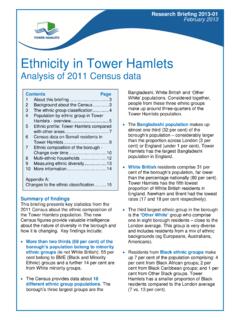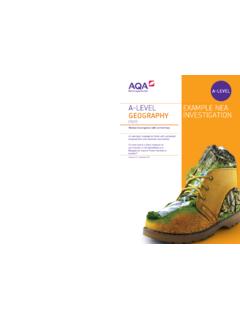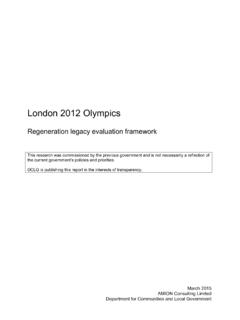Transcription of Health inequalities in London - GOV.UK
1 Health inequalities in London Contents 2 Executive summary Background and economic impact Life expectancy Healthy life expectancy Infant mortality School readiness DTaP/IPV/Hib immunisation uptake Childhood excess weight Adults who are physically active Adults who smoke Work days lost due to sickness absence Homelessness TB Sexually transmitted infections Cancer mortality Cardiovascular disease mortality Respiratory disease mortality Educational attainment 3 4 6 7 8 9 10 11 12 13 21 20 19 18 14 15 16 17 3 Compared to England Executive summary There are substantial variations in Health and wellbeing outcomes in London compared to England 4 The purpose of this report is to: describe the importance of Health inequalities describe the economic case for investing in Health inequalities provide a descriptive analysis of Health inequalities in London Health inequalities are differences between people or groups due to different factors including.
2 These differences may result in people who are worse off experiencing poorer Health and shorter lives Social Geographical Biological 5 In England, the cost of treating illness and disease arising from Health inequalities has been estimated at billion per year Tackling tobacco use alone would save 61 million a year in a deprived London borough such as Newham In England, lost taxes and higher welfare payments resulting from Health inequalities cost in the region of 28 32 billion In England, Health inequalities lead to productivity losses to industry of between 31 33 billion each year NICE (2012) Health inequalities and population Health Health inequalities affect the economy and local services 6 There are wide variations in life expectancy across London .
3 For women, the difference between the highest and lowest life expectancy is years, for men the difference is years. The difference in life expectancy in London between women and men is years Barking and Dagenham years Kensington and Chelsea years years Kensington and Chelsea years tower hamlets Life expectancy at birth (2011-13) Compared to England Source: 7 There are wide variations in healthy life expectancy (the average number of years a person would expect to live in good Health ) across London . For women, the difference between the highest and lowest healthy life expectancy is years, for men the difference is years. The difference in healthy life expectancy in London between women and men is years Healthy life expectancy at birth (2011-13) Source: Barking and Dagenham years Richmond upon Thames years tower hamlets years Richmond upon Thames years Compared to England 8 Infant mortality (2011-13) Source: PHE London (2015) Reducing infant mortality in London : An evidence based resource per week in London do not live to see their first birthday Risk factors for infant mortality 10 babies The infant mortality rate (IMR) in London ( per 1,000 live births) was less than that of England ( per 1,000 live births) There are wide variations in infant mortality.
4 The IMR in Hackney is about higher than that of Bromley IMRs in London have reduced by one-third over the past 10 years 2001-03 per 1,000 live births 2011-13 per 1,000 live births The IMR for babies born to teenage mothers is 44% higher than mothers aged 20-39 Babies born to mothers in the routine and manual group have a 4x higher IMR The IMR for babies of mothers born in the Caribbean is almost 2x higher than for mothers born inside the UK Compared to England 9 School readiness (2013-14) Source: PHE London (2015) Improving school readiness: Creating a better start for London children in London aged 5 years do not achieve a good level of development inequalities in school readiness There are wide variations in the proportion of children who are school ready in London : of children in Lewisham are school ready compared to in Hillingdon The proportion of children in London who are school ready has increased by percentage points 2012-13 2013-14 2 in 5 England London Compared to England 52% 69% Gender Girls are more likely to have a GLD* compared to boys *GLD.
5 Good level of development Ethnicity White British pupils are more likely to have a GLD compared to Gypsy/Roma pupils 19% 63% Free school meals Pupils not eligible for FSM are more likely to have a GLD compared to those who are eligible for FSM 45% 60% 10 Source: NICE (2009) Reducing differences in uptake of immunisations England London There are wide variations in immunisation uptake, ranging from in Camden to in Enfield Immunisation uptake has decreased by percentage points in the past 4 years 2010-11 2013-14 1 in 10 babies in London do not complete the primary immunisation course of DTaP/IPV/Hib by their first birthday Benchmarked against a goal Evidence has shown that the following groups of children and young people are at risk of not being fully immunised.
6 Vulnerable children, such as those whose families are travellers, asylum seekers or are homeless those who have missed previous vaccinations those not registered with a GP those with physical or learning disabilities children of teenage or lone parents children who have a chronic illness children from some minority ethnic groups Immunisation uptake in London was the lowest in England DTaP/IPV/Hib immunisation uptake at 1 year (2011-13) 11 Childhood excess weight (2013-14) Source: Most deprived 4-5 and 10-11 year olds are 2x more likely to be obese than least deprived Between 2006-07 and 2013-14 the prevalence of overweight children in London remained stable in children aged 4-5 years and increased in children aged 10-11 years 4-5 year olds 2006-07 2013-14 Excess weight (4-5 years) Excess weight (10-11 years)
7 1 out of 5 children aged 4-5 years in London are overweight or obese 2 out of 5 children in London are an unhealthy weight when they start secondary school Rates of childhood overweight and obesity are higher in London than in the rest of England There are wide variations in the proportion of children who are an unhealthy weight in London 10-11 year olds 2006-07 2013-14 Compared to England 12 Educational attainment (2013-14) Source: 3 in 5 children in London achieve 5 or more GCSEs at grades A*-C (including English and Maths) There are wide variations in GCSE attainment. GCSE attainment in children in Kensington and Chelsea ( ) is higher than Lewisham ( ) England London Since 2004 London schools have outperformed the rest of the country for good achievement of GCSEs at Key Stage 4 Low income is a strong predictor of low educational performance This feeds into disadvantage in adulthood and transmits poverty across generations Poor mental Health can lead to a range of problem behaviours that affect concentration, causing difficulties and low achievement at school Compared to England 13 Adults who are physically active (2014) Source.
8 3 out of 5 Londoners achieve at least 150 minutes of physical activity per week England London There are wide variations in physical activity. Londoners living in Richmond upon Thames are more likely to be physically active than those living in Barking and Dagenham The proportion of Londoners who are physically active has remained stable 2012 2014 inequalities in physical activity 3 in 5 men are physically active compared to 1 in 2 women Disabled people are half as likely to be physically active as non disabled people 19-34 year olds are more likely to be physically active compared to 55-64 year olds White Asian Black Compared to England 14 Adults who smoke (2013) Source: 1 out of 6 Londoners aged over 18 years smoke England London There are wide variations in smoking prevalence.
9 Londoners living in Barking and Dagenham are 2 times more likely to be smokers than those living in Richmond upon Thames The proportion of Londoners who smoke has reduced by 10% 2010 2013 inequalities in smoking prevalence Compared to England 1 in 5 men are smokers compared to 1 in 6 women 25-29 year olds are times more likely to be smokers compared to 55-59 year olds White Black Asian People in the routine and manual group are times more likely to be smokers compared to those in professional groups 15 Source: ONS (2014) Sickness Absence in the Labour Market Force of working days were lost due to sickness absence in the previous week in London England London There are wide variations in sickness absence.
10 Sickness absence in the City of London ( ) and Bexley ( ) are 37 and higher than Brent ( ) The proportion of work days lost due to sickness absence has remained stable 2009-11 2010-12 inequalities in sickness absence Workers in London have the lowest percentage of work days lost to sickness absence in England People working in process plant and machine operations occupations are 71% more likely to have an instance of sickness compared to those in professional occupations Work days lost due to sickness absence (2010-12) Women are 42% more likely to have time off work through sickness than males Compared to England 16 Homelessness (2013-14) Source: Homelessness in London has increased Homelessness acceptances 2010-11 per 1,000 2013-14 per 1,000 Households in temporary accommodation 2010-11 per 1,000 2013-14 per 1,000 Homelessness acceptances Households in temporary accommodation 17,030 households in London were accepted as being homeless, this accounts for 1 in 3 of acceptances in England Homelessness is an issue for most local authorities in London Compared to England 43,310 households in London were living in temporary accommodation, this accounts for 3 out of 4 of such households in England Homelessness is associated with severe poverty and adverse Health , education and social outcomes.
















